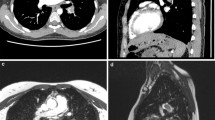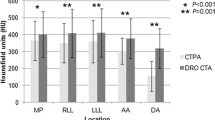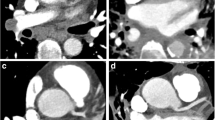Abstract
In a multi-center trial, gadolinium enhanced magnetic resonance angiography (MRA) for diagnosis of acute pulmonary embolism (PE) had a high rate of technically inadequate images. Accordingly, we evaluated the reasons for poor quality MRA of the pulmonary arteries in these patients. We performed a retrospective analysis of the data collected in the PIOPED III study. We assessed the relationship to the proportion of examinations deemed “uninterpretable” by central readers to the clinical centers, MR equipment platform and vendors, degree of vascular opacification in different orders of pulmonary arteries; type, frequency and severity of image artifacts; patient co-morbidities, symptoms and signs; and reader characteristics. Centers, MR equipment vendor and platform, degree of vascular opacification, and motion artifacts influenced the likelihood of central reader determinations that images were “uninterpretable”. Neither the reader nor patient characteristics (age, body mass index, respiratory rate, heart rate) correlated with the likelihood of determining examinations “uninterpretable”. Vascular opacification and motion artifact are the principal factors influencing MRA interpretability. Some centers obtain better images more consistently, but the reasons for differences between centers are unclear.
Similar content being viewed by others
References
Stein PD, Chenevert TL, Fowler SE, et al. for the PIOPED III Investigators (2010) Gadolinium enhanced magnetic resonance angiography for pulmonary embolism: a multicenter prospective study (PIOPED III). Ann Int Med 152:434–443
Fisher L, van Belle G (1993) Biostatistics: a methodology for the health sciences. New York, Wiley, p 206
Gibbons JD, Chakraborti S (1992) Nonparametric statistical inference. Marcel Dekker, Inc., 3rd edn. New York, 295
Gibbons JD, Chakraborti S (1992) Nonparametric statistical inference. Marcel Dekker, Inc., 3rd edn. New York, 264
Abujudeh HH, Kaewlai R, Farsad K, Orr E, Gilman M, Shepard JO (2009) Computed tomography pulmonary angiography: an assessment of the radiology report. Acad Radiol 16:1309–1315
Hadizadeh DR, Gieseke J, Lohmaier SH et al (2008) Peripheral MR angiography with blood pool contrast agent: prospective intraindividual comparative study of high-spatial-resolution steady-state MR angiography versus standard-resolution first-pass MR angiography and DSA. Radiology 249:701–711
Woodard PK, Chenevert TL, Sostman HD, Jablonski KA, Stein PD, Goodman LR, Londy FJ, Narra V, Hales CA, Hull RD, Tapson VF, Weg JG (2011) Signal quality of single dose gadobenate dimeglumine pulmonary MRA examinations exceeds quality of MRA performed with double dose gadopentetate dimeglumine. Int J Cardiovasc Imaging. doi:10.1007/s10554-011-9821-6
Loubeyre P, Revel D, Douek P et al (1994) Dynamic contrast-enhanced MR angiography of pulmonary embolism: comparison with pulmonary angiography. AJR Am J Roentgenol 162:1035–1039
Ohno Y, Higashino T, Takenaka D et al (2004) MR angiography with sensitivity encoding (SENSE) for suspected pulmonary embolism: comparison with MDCT and ventilation-perfusion scintigraphy. AJR Am J Roentgenol 183:91–98
Ersoy H, Goldhaber SZ, Cai T et al (2007) Time-resolved MR angiography: a primary screening examination of patients with suspected pulmonary embolism and contraindications to administration of iodinated contrast material. AJR Am J Roentgenol 188:1246–1254
Blum A, Bellou A, Guillemin F, Douek P, Laprevope-Heully MC, Wahl D, GENEPI study group (2005) Performance of magnetic resonance angiography in suspected acute pulmonary embolism. Thromb Haemost 93:503–511
Goodman LR (2005) Small pulmonary emboli: what do we know? (Editorial) Radiology 234:654–658
Stein PD, Henry JW (1997) Prevalence of acute pulmonary embolism in central and subsegmental pulmonary arteries and relation to probability interpretation of ventilation/perfusion lung scans. Chest 11:1246–1248
Stein PD, Fowler SE, Goodman LR, et al. for the PIOPED II Investigators (2006) Multidetector computed tomography for acute pulmonary embolism. N Eng J Med 354:2317–2327
Quinn MF, Lundell CJ, Klotz TA et al (1987) Reliability of selective pulmonary arteriography in the diagnosis of pulmonary embolism. Am J Roent 149:469–471
Krishnam MS, Tomasian A, Deshpande V et al (2008) Noncontrast 3D steady-state free-precession magnetic resonance angiography of the whole chest using nonselective radiofrequency excitation over a large field of view: comparison with single-phase 3D contrast-enhanced magnetic resonance angiography. Invest Radiol 43:411–420
Wells PS, Anderson DR, Rodger M et al (2001) Excluding pulmonary embolism at the bedside without diagnostic imaging: management of patients with suspected pulmonary embolism presenting to the emergency department by using a simple clinical model and d-dimer. Ann Intern Med 135:98–107
Acknowledgments
This study was supported by Grants HL081593, HL177150, HL077149, HL077151, HL077154, HL081594, HL077358, HL077155, and HL077153 from the U.S. Department of Health and Human Services, Public Health Services, National Heart, Lung, and Blood Institute, Bethesda, Maryland.
Conflict of interest
Dr. Woodard received research support from GE Healthcare and Siemens Medical Systems.
Author information
Authors and Affiliations
Corresponding author
Rights and permissions
About this article
Cite this article
Dirk Sostman, H., Jablonski, K.A., Woodard, P.K. et al. Factors in the technical quality of gadolinium enhanced magnetic resonance angiography for pulmonary embolism in PIOPED III. Int J Cardiovasc Imaging 28, 303–312 (2012). https://doi.org/10.1007/s10554-011-9820-7
Received:
Accepted:
Published:
Issue Date:
DOI: https://doi.org/10.1007/s10554-011-9820-7




